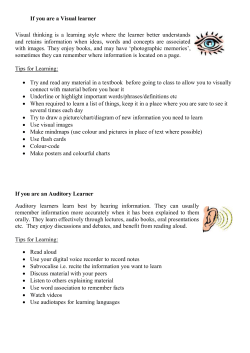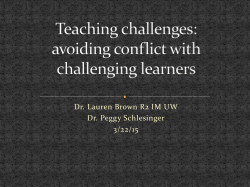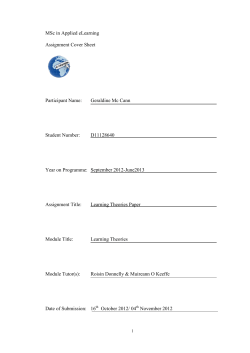
The Relationship between Iranian EFL Learners` Vocabulary
International Research Journal of Applied and Basic Sciences © 2015 Available online at www.irjabs.com ISSN 2251-838X / Vol, 9 (4): 644-647 Science Explorer Publications The Relationship between Iranian EFL Learners’ Vocabulary Learning Strategies and Learner Autonomy in Intermediate and Elementary EFL Learners Sara Naraghi¹,², Seyyed Hassan Seyyedrezaei³* 1. Department of English Language Teaching, Golestan Science and Research Branch, Islamic Azad University, Gorgan, Iran 2. Department of English Language Teaching, Gorgan Branch, Islamic Azad University, Gorgan, Iran 3. Department of English Language Teaching, Aliabad Katoul Branch, Islamic Azad University, Aliabad Katoul, Iran *Corresponding Author Email: srezaei.sh@gmail.com ABSTRACT: The studies of vocabulary learning and the strategy in learning vocabulary are so interesting that have attracted much attention in language teaching. The present study aims to investigate the relationship between Iranian EFL learners’ vocabulary learning strategies and learner autonomy in intermediate and elementary level. Learner autonomy is a huge assistance for learners in vocabulary learning since it provides the learners with numerous diverse privileges such as independency from teacher. To this end, the Oxford Placement Test (OPT) was administered to 85 female students in an English Institute of Gorgan, Iran, to understand their English proficiency levels. The participants took a Language Learning Strategies Questionnaire to determine learners’ strategies in learning vocabulary and Learners’ autonomy questionnaire to evaluate students’ autonomy. The collected data finally showed that there is a relationship between intermediate EFL learner’s vocabulary learning strategies and learner autonomy, there is no significant relationship between elementary EFL learner’s vocabulary learning strategies and learner autonomy and totally, there is a difference between vocabulary learning strategies used by intermediate and elementary learners. Key words: Autonomous learner, Learner autonomy, Vocabulary learning strategies INTRODUCTION English vocabulary is getting bigger constantly with time. Pittman (2003) felt that English vocabulary is increasing little by little with the incorporation of technology and culture. Therefore, every day large number of new words is introduced and learning and knowing new vocabulary and in better words lexical items is critical for both EFL and ESL learners. Several studies (Barcroft, 2009; Borer, 2007; Catalán, 2003; Fan, 2003; Gu, 2002) reached to the point that L2 learners who are more proficient effectively employ different vocabulary learning strategies considerably more repeatedly than those who are less proficient and apply learning strategies that require more cognitive effort. In this regard, the notion of autonomy has been paid a lot of attention generally and particularly in educational environments. In fact, this capability or capacity should come true for better learning. According to (Little, 1991), autonomy refers to “a capacity - for detachment, critical reflection, decision-making, and independent action. The capacity for autonomy will be displayed both in the way the learner learns and in the way he or she transfers what has been learned to wider contexts”(p.4). To set up different characteristics of the autonomous learner in the process of language learning, it is remarkable to review a variety of definitions and dimensions of learner autonomy. For the first time autonomy definition was brought about by Holec as “the ability to take charge of one’s own learning’ (as cited in Little 2006, p.1). According to Benson (1997), autonomy may be applied in five different ways (1) in situations where learners study completely on their own (2) for those skills and capabilities that may be applied in self-directed learning (3) for an natural capability which is censored by institutional education (4) for boosting responsibility to learn on their own (5) for the right of learners to determine the direction of their own learning. Little (1991) felt Intl. Res. J. Appl. Basic. Sci. Vol., 9 (4), 644-647, 2015 that “learner autonomy does not mean that the teacher becomes redundant, abdicating his/her control over what is transpiring in the language learning process”. This was supported by Dickinson (1987, pp.16-17) that autonomy “may mean a learner working away in isolation, but it is more likely to describe a situation in which learners undertake responsibility for a part of their learning. Also, it may mean a learner using materials which are designed to guide his every step and leave little freedom of choice, or it may describe a situation in which the learner designs his own course and makes decisions about when and how he is going to be assessed”. Totally, teachers and instructors should bear in mind that in today world autonomous language learners ought to be seen as an educational goal and consequently should provide their learners with a suitable learning environment to foster their autonomy. In other words, there is an agreement that the autonomous learner hold a constructive attitude and a willingness to be practical in self-management and in interaction with others (Little 2002). As a result, L2 learners are acting and playing as planner, organizer, administrator, thinker, self-assessor, self-motivator, partner of other learners, and peer assessor; while the teachers and instructors are information provider, counselor, authentic language user, manager, materials writer, assessor, evaluator, administrator, and organizer (Gardner & Miller 1999, Reinders, 2010). Having defined the advantages of learner autonomy on the one hand, and the importance of a guiding teacher on the other, it is now time to have a look at possible methods to foster learner autonomy. METHODOLOGY The primary purpose of this study was to investigate the relationship between Iranian EFL learners’ vocabulary learning strategies and learner autonomy in intermediate and elementary EFL learners. In order to getting the result, vocabulary learning strategies questionnaires (VLSQ) and learner’s autonomy questionnaire were used. The present study is intended to provide answers for the following research questions: 1. Is there any significant relationship between intermediate EFL learner’s vocabulary learning strategies and learner autonomy? 2. Is there any significant relationship between elementary EFL learner’s vocabulary learning strategies and learner autonomy? Participants The participants of this study were 85 female language learners at Giti and Shokouh English language institute in Gorgan, in the north of Iran. The subjects’ language proficiency was established through using an “Oxford Placement Test”. (OPT) was administered to select 85 students with intermediate proficiency level and elementary one. They were homogenized through an OPT. All of the participants were native speakers of Farsi. Procedure A couple of questionnaires and a language proficiency test were utilized in this study. Language learning strategies were identified through self report. Although self report may be inaccurate if the learners do not report truthfully, it is still the only way to identify learner’s mental processing; learning strategies are for the most part unobservable, though some may be associated with an observable behavior. For example, a learner could use selective attention (unobservable) to focus on the main ideas while listening to a newscast and could then decide to take notes (observable) in order to remember the information. In almost all learning context, the only way to find out whether student are using learning strategies while engaged in a language task is to ask them(Chamot, 2004). Instruments Via considering the goal of the study, a number of instruments for collecting the relevant data were used. The useful instruments and materials were presented and defined as follows: Oxford Placement Test (OPT) At the beginning of research, subjects were required to take OPT to make sure that they were homogeneous with respect to their proficiency in language skills as a whole. The questions of the mentioned test were taken from ‘Oxford University Press and University of Cambridge Local Examinations Syndicate’ by Fischer (2001). The OPT was administered to categorize participants into the higher and lower levels of English proficiency. OPT consists of 60 multiple-choice items. Students who could answer 1 to 10 questions correctly were classified in elementary level and Students who could answer 21 to 30 items correctly were classified in intermediate level. By using this test, it was proved that language proficiency level of the participant was intermediate or elementary. Allotted time to answer the questions was 30 minutes. 645 Intl. Res. J. Appl. Basic. Sci. Vol., 9 (4), 644-647, 2015 Table 1. Oxford Placement Test Scoring Scale Language Proficiencylevel Score 1-10 Elementary Pre-intermediate Intermediate 11-20 21-30 31-40 41-60 Upper-intermediate Advance Vocabulary Learning Strategies Questionnaire (VLSQ) The researcher utilized a vocabulary learning strategies questionnaire to determine students' self-reported vocabulary learning strategy use. The questionnaire was used by Gu and Johnson (1996) and Tahmasebi (1999). The questionnaire was subject to a pilot study to check the reliability and validity as it was a new context. Learners’ Autonomy Questionnaire The questionnaire was designed by Zhang and Li (2004, cited in Dafei, 2007) which include 21 items (5 point Likert-scale questionnaire) and also was subject to pilot study in order to check reliability and validity. RESULTS After collecting and summarizing the data, SPSS 16 was used to analyze the data. In the first section, the data collected using descriptive statistics; descriptions of all of the latent variables are done. Then after checking the normality of distribution using SPSS statistical correlation between dependent and independent variables are examined. In the end, research hypotheses are examined. Data Analysis of Hypothesis 1 The First hypothesis: There is no significant relationship between vocabulary learning strategies and learner’s autonomy in the intermediate learners. Table 2. The Output Correlation Coefficient for First Hypothesis Vocabulary learning strategy Vocabulary strategy learning Intermediate level Pierson correlation Meaningful Quantity Pierson correlation Meaningful Quantity intermediate level 1 .743(**) 85 .000 49 .743(**) 1 .000 49 49 According to Table 2, it can be concluded, since sig value is (0.00), which is less than the value (0.05), the null hypothesis (H0) is statistically rejected. So there is a significant correlation between the two variables. So the first hypothesis of this research was rejected. However, given the correlation coefficient equal to (0.743) is the cause of much of the range (0.75 to 0.5) has a strong direct correlation between these two variables together. Data Analysis of Hypothesis 2 The second hypothesis of the study is, there is no significant relationship between vocabulary learning strategies and learners’ autonomy at the elementary level. Table 3. Output Correlation Coefficient Test for Second Hypothesis Vocabulary strategy Vocabulary learning strategy Elementary level Pierson correlation Meaningful Quantity Pierson correlation Meaningful learning 1 Quantity 85 .100 .562 36 Elementary level .100 .562 36 1 36 ** Correlation is significant at the 0.01 level (2-tailed). According to Table 3, sig is (0.100) which is greater than (0.05). So there is no significant relationship between the two variables and the hypothesis is accepted. 646 Intl. Res. J. Appl. Basic. Sci. Vol., 9 (4), 644-647, 2015 CONCLUSION In sum, the results of this small study indicate that there is a relationship between intermediate EFL learner’s vocabulary learning strategies and learner autonomy. In contrast, there is no significant relationship between elementary EFL learner’s vocabulary learning strategies and learner autonomy. A number of recent studies have concluded that L2 learners who are more proficient use a variety of VLS significantly more often than less proficient students, and use learning strategies that require more cognitive effort. Actually, “It has been suggested that L2 learners can be categorized on the basis of their learning strategies” (Ahmed, 1989, p.7). REFERENCES Ahmed M. 1989. Vocabulary learning strategies. In P. Meara (Ed.), British studies in applied linguistics: Vol. 4. Beyond words (pp. 3-14). London: British Association of Applied Linguistics/Center for Language Teaching. Barcroft J. 2009. Strategies and performance in intentional L2 vocabulary learning. Language Awareness, 18(1), 74-89. Borer L. 2007. Depth of processing in private and social speech: Its role in the retention of word knowledge by adult EAP learners. Canadian Modern Language, Review, 64(2), 269-295. Benson P. 1997. The philosophy and politics of learner autonomy. In Benson, P & Voller, P. Eds. Autonomy & Independence in language learning. London and New York: Longman. Review, 64(2), 269-295. Catalán R. 2003. Sex differences in L2 vocabulary learning strategies. International Journal of Applied Linguistics, 13(1), 54-77. Chamot AU.2004. Issues In Language Learning Strategy Research And Teaching. Electronic Journal of Foreign Language Teaching, 1(1), 14-26. Dafei D. 2007. An exploration of the relationship between learner autonomy and English proficiency. Professional Teach ing Article, 1-23. Dickinson L.1987. Self-Instruction in language learning. Cambridge: Cambridge University Press. Fan M.2003. Frequency of use, perceived usefulness, and actual usefulness of second language vocabulary strategies: A study of Hong Kong learners. Modern Language Journal, 87(2), 222-241. Gardner D, Miller M.1999. Establishing Self-access. From theory to practice. Cambridge: Cambridge University Press. Gu Y, Johnson RK. 1996. Vocabulary learning strategies and language learning outcomes. Language Learning, 46(6), 43-679. Gu Y. 2002. Gender, academic major, and vocabulary learning strategies of Chinese EFL learners. Regional English Language Centre Journal, 33(1), 35. Little D. 1991. Learner autonomy 1: Definitions, issues and problems. Dublin: Authentik. Little D.2002. Learner autonomy and second/ foreign language learning. LLAS Centre Languages, Linguistics and Area Studies, 15(2), 94120 Retrieved October Pittman, W. (2003). Building vocabulary through prefixes, roots and suffixes. The Int ernet TESL Journal, 9(7), 1-2. Retrieved from http://iteslj.org/Techniques/Pittman-Building Vocabulary.html Little D.2006. Learner autonomy: Drawing together the threads of self-assessment, goal- setting and reflection. Training teachers to use the European Language Portfolio. Retrieved from http://archive.ecml.at/mtp2/Elp_tt/Results/DM_layout/00_10/06/06%20Supplementary20text.pdf. Reinders H.2010. Towards classroom pedagogy for learner autonomy: A framework of independent language learning skills. Australian Journal of Teacher Education 35(5), 40-55. Tahmasebi A.1999. Vocabulary learning strategies and the level of language proficiency. Unpublished MA thesis, Tarbiat Modarr es University. Tehran, Iran. 647
© Copyright 2025









